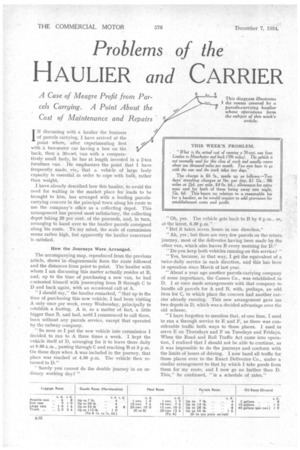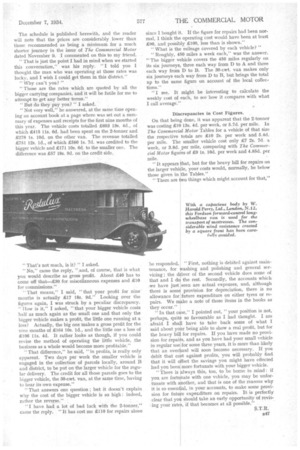Problems of the
Page 60

Page 61

If you've noticed an error in this article please click here to report it so we can fix it.
HAULIER and CARRIER
A Case of Meagre Profit from Parcels Carrying. A Point About the Cost of Maintenance and Repairs
IN discussing with a haulier the business of parcels carrying, I have arrived at the point where, after experimenting first with a two-seater car having a box on the back, then a 30-cwt. van with a comparatively small body, he has at length invested in a 2-ton furniture van. He emphasizes the point that 1 have frequently made, viz., that a vehicle of large body capacity is essential in order to cope with bulk, rather than weight.
I have already described how this haulier, to avoid the need for waiting in the market place for loads to be brought to him, has arranged with a leading parcelscarrying concern in the principal town along his route to use the company's office as a collecting depot. This arrangement has proved most satisfactory, the collecting depot taking 20 per cent. of the proceeds, and, in turn, arranging to hand over to the haulier parcels consigned along his route. To my mind, the scale of commission seems rather high, but apparently the haulier concerned is satisfied.
How the Journeys Were Arranged.
The accompanying map, reproduced from the previous article, shows in diagrammatic form the route followed and the distances from point to point. The haulier with whom I am discussing this matter actually resides at B, and, up to the time of purchasing a new van, he had contented himself with journeying from B through C to D and back again, with an occasional call at A.
"I should say," the haulier remarked, "that up to the time of purchasing this new vehicle, I had been visiting A only once per week, every Wednesday, principally to establish a footing. A is, as a matter of fact, a little bigger than B, and had, until I commenced to call there, been without any parcels service, except that operated by the railway company. .
"So soon as I put the new vehicle into commission I decided to run to A three times a week. I kept the vehicle itself at D, arranging for it to leave there daily at 9.30 a.m., passing through C and reaching B at 3 p.m. On those days when A was included in the journey, that place was reached at 4.30 p.m. The vehicle then returned to D."
"Surely you cannot do the double journey in an ordinary working day? "
"Oh, yes. The vehicle gets back to B by 6 p.m_ or, at the latest, 6.30 p.m."
"But it takes seven hours in one direction."
" Ah, yes ; but there are very few parcels on the return journey, most of the deliveries having been made by the other van, which also leaves B every morning for D."
"Do you keep both vehicles running on this service? '• " Yes, because, in that way. I get the equivalent of a twice-daily service in each direction, and this has been in operation since March of last year. " ' About a year ago another parcels-carrying company of some importance, the Cameo Co., was established in D.I at once made arrangements with that company to handle all parcels for A and B, with, perhaps, an odd item for C, to which place the concern had another carrier already running. This new arrangement gave me two depots in D, which was a decided advantage over the old scheme.
"I have forgotten to mention that, at one time, I used to run a through service to E and F, as there was considerable traffic both ways to those places. I used to serve E on Thursdays and F on Tuesdays and Fridays. When the Road and Rail Traffic Act came into operation, I realized that I should not be able to continue, as it was impossible to do the journeys and conform with the limits of hours of driving. I now hand all traffic for those places over to the Exact Deliveries Co., under a similar arrangement to that by which I take goods from them for my route, and I now go no further than D. This," he continued, "is a schedule of rates." The schedule is published herewith, and the reader will note that the prices are considerably lower than those recommended as being a minimum for a much shorter journey in the issue of Tile Commercial Motor dated November 9. I commented on this to my friend.
" That is just the point I had in mind when we started this conversation," was his reply. "I told you I thought the man who was operating at those rates was lucky, and I wish I could get them in this district."
"Why can't you?"
"Those are the rates which are quoted by all the bigger carrying companies, and it will be futile for me to attempt to get any better terms."
"But do they pay you? " I asked.
"Not very well," he answered, at the same time opening an account book at a page where was set out a summary of expenses and receipts for the first nine months of this year. The vehicle costs totalled £693 13s. 4d., of which £415 1 is, 6d. had been spent on the 2-tonner and £278 Is. 10d. on the other van. The revenue totalled £751 12s. Id., of which £580 Is. 7d. was credited to the bigger vehicle and £171 105. 6d. to the smaller one. The difference was £57 18s. 9d. on the credit side.
" That's not much, is it? " I asked.
"No," came the reply, "and, of course, that is what you would describe as gross profit. About £40 has to come off that—£30 for miscellaneous expenses and £10 for commissions."
"That means," I said, "that your profit for nine months is actually £17 18s. 9d." Looking over the figures again, I was struck by a peculiar discrepancy. " How is it," I asked, "that your bigger vehicle costs half as much again as the small one and that only the bigger vehicle makes a profit, the little one running at a• loss? Actually, the big one makes a gross profit for the nine months of £164 10s. Id., and the little one a loss of £106 11s. 4d. It rather looks as though, if you could revise the method of operating the little vehicle, the business as a whole would become more profitable."
"That difference," he said, "in profits, is really only apparent. Two days per week the smaller vehicle is engaged in the collection of parcels locally, around B and district, to be put on the larger vehicle for the regular delivery. The credit for all those parcels goes to the bigger vehicle, the 30-cwt, van, at the same time, having to bear its own expense."
" That answers one question ; but it doesn't explain why the cost of the bigger vehicle is so high; indeed, rather the reverse."
"I have had a lot of bad luck with the 2-tonner," came the reply. "It has cost me £110 for repairs alone
since I bought it. lithe figure for repairs had been normal, I think the operating cost would have been at least £90, and possibly £100, less than is shown."
"What is the mileage covered by each vehicle? "
" Roughly, 450 miles a week each," was the answer. "The bigger vehicle covers the 450 miles regularly on its six journeys, three each way from D to A and three each way from D to B. The 30-cwt. van makes only six journeys each way from D to B, but brings the total up to the same figure on account of the local collections."
"I see. It might be interesting to calculate the weekly cost of each, to see how it compares with what I call average."
Discrepancies in Cost Figures.
On that being done, it was apparent that the 2-tormer was costing £10 13s. 4d. per week, or 5.7d. per mile. In The Commercial Motor Tables for a vehicle of that size the respective to+qls are £10 2s. per week and 5.4d. per mile. The smaller vehicle cost only £7 2s. 7d. a week, or 3.8d. per mile, comparing with The Commercial Motor figures of £9 ls. 10d. per week and 4.85d. per mile.
" It appears that, but for the heavy bill for repairs on the larger vehicle, your costs would, normally, be below those given in the Tables."
"There are two things which might account for that,"
he responded. "First, nothing is debited against maintenance, for ashing and polishing and general servicing; the driver of the second vehicle does some of that and I dc the rest. Secondly, the accounts which we have just 'seen are actual expenses, and, although there is some provision for depreciation, there is no allowance for future expenditure on either tyres or repairs. We make a note of those items in the books as they occur."
"In that case," I pointed out, "your position is not, perhaps, quite so favourable as I had thought. I am afraid I shall have to take back some of what I said about your being able to show a real profit, but for the heavy bill for repairs. If you have made no provision for repairs, and as you have had your small vehicle in regular use for some three years, it is more than likely that an overhaul will soon become necessary. If you debit that cost against profits, you will probably find that it will offset the savings you might have effected had you been more fortunate with your bigger vehicle.
"There is always this, too, to be borne in mind : if you are fortunate with one vehicle, you may be imf orinnate with another, and that is one of the reasons why it is so essential, in your accounts, to make some provision for future expenditure on repairs. It is perfectly clear that you should take an early opportunity of revising your rates, if that becomes at all possible."




























































































